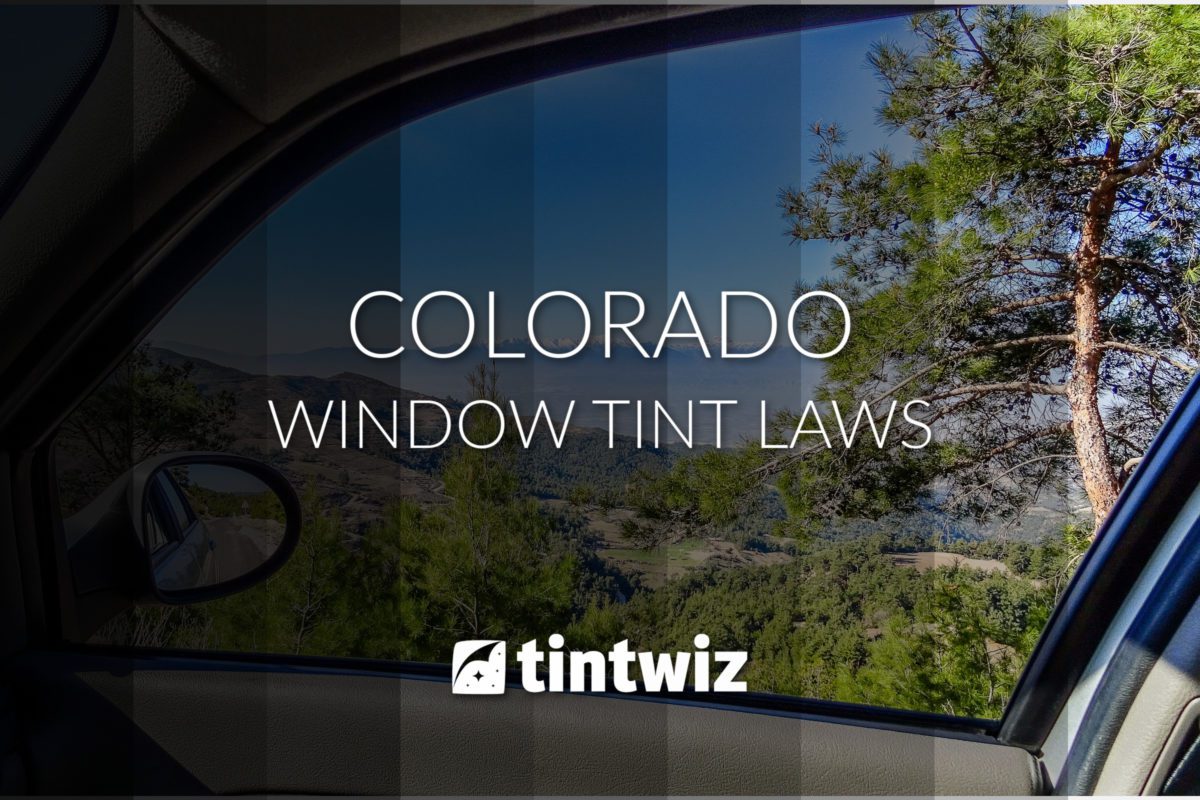Darkest legal tint for Sedans in Colorado
- Windshield: Non-reflective 70% VLT window tint is allowed on top 4 inches of the windshield.
- Front Side windows: Must allow more than 27% of light in
- Back Side windows: Must allow more than 27% of light in
- Rear window: Must allow more than 27% of light in
Darkest legal tint for SUV and Vans in Colorado
- Windshield: Non-reflective 70% VLT window tint is allowed on top 4 inches of the windshield.
- Front Side windows: Must allow more than 27% of light in
- Back Side windows: Must allow more than 27% of light in
- Rear window: Must allow more than 27% of light in
Table of contents
- Darkest legal tint for Sedans in Colorado
- Darkest legal tint for SUV and Vans in Colorado
- Can You Tint Side Windows of a Car in Colorado?
- Legal Car Windshield Tint in Colorado
- Can You Tint Side Windows of an SUV, Van, or Truck in Colorado?
- Legal Van, Truck, and SUV Windshield Tint in Colorado
- Other Window Tint Laws in Colorado
- Are There Medical Exemptions for Auto Window Tint in Colorado?
- Penalties for Window Tint Law Violations in Colorado
Please note: The accuracy, completeness, adequacy or currency of the content is not warranted or guaranteed. We are not lawyers or a law firm and we do not provide legal advice. We recommend you consult a lawyer or other appropriate professional if you want legal advice.

Applying window tint to the windows of a car comes with multiple benefits and is one of the most cost effective improvements you can make to a vehicle. Window film blocks 99% of the sun’s harmful UV light, thus preventing the risk of damage to your skin and also preventing the fading, peeling, and cracking that can make a vehicle’s upholstery, dashboard, and other surfaces break down and denigrate the overall value of the automobile.
Tinting a car’s windows also reduces the amount of infrared light that enters the cabin, keeping the vehicle cooler and more comfortable, saving energy costs by reducing the need for AC, and protecting the passengers and sensitive equipment within the vehicle against heat damage.
Vehicle window tint also reduces the intensity of the glare of sunshine during the daytime and reduces the effect of headlights during night driving, helping you stay safer and more comfortable while you are behind the wheel.
Car window tint can also increase the privacy of those inside the car, truck, van, or SUV and improve the aesthetic appeal of the vehicle. It also adds extra tensile strength to the glass windows, helping prevent them from shattering apart if struck or during an accident, so window film can make a car safer, too.
With its high elevation and many sunny days, Colorado is a state where car window tint is a must. But if you are going to get window film for a vehicle in Colorado, you must understand Colorado tint laws, because the penalty for illegal window tint in Colorado can be harsh. Window tint laws in Colorado were officially enacted in the year 1995 but have been changed several times over the years and are always subject to change again.
Read on to learn what car window tint is legal in Colorado in 2021 and what window film will get you in trouble with police or inspectors.
Can You Tint Side Windows of a Car in Colorado?
Yes, all of the side windows of a car can be tinted in the state of Colorado, and unlike in many states, this includes the front side windows, meaning those beside the driver and the front seat passenger. All rear side windows can also be tinted. The window film cannot be mirrored or metallic in appearance.
Colorado state law mandates that window tint on the side windows of vehicles be rated at a 27% VLT or greater, meaning it allows 27% or more of the sun’s visible light to transmit into the vehicle. This is true whether the tint is applied to clear windows or is layered over windows with factory tint. Overall, side windows must have a visible light transmission percentage rating of 27% or higher.
Legal Car Windshield Tint in Colorado
Colorado window film rules stipulate that only the strip along the top four inches of a car’s windshield may be tinted, and that this tint must have a 70% VLT rating and be non-reflective. This type of tint can curtail the harsh glare of the sun without blocking any clarity of view, and as it cannot be reflective, it will not glint and flash into the eyes of drivers in oncoming lanes.
The rear window or a car in Colorado may be tinted down to the same 27% VLT as the side windows of the car, and note that 27% VLT tint is dark enough to add significant privacy to a vehicle and to improve its appearance as well. The fact that the same darkness of tint is allowed on all but the front windshield allows for a uniformity of appearance.
Can You Tint Side Windows of an SUV, Van, or Truck in Colorado?
All of the side windows of a truck, van, or SUV can be tinted in Colorado, and the exact same rules that apply to cars apply to these larger vehicles: side windows may be tinted to a darkness of 27% VLT. The tint cannot be metallic or mirrored in appearance and must be no more reflective than with a standard glass window.
Legal Van, Truck, and SUV Windshield Tint in Colorado
The rules for window tint for windshields of larger vehicles in Colorado are exactly the same as they are for cars: a 70% VLT or lighter strip of non-reflective tint can be run along the top four inches of the glass windshield.
Other Window Tint Laws in Colorado
Colorado regulations stipulate that if the rear windows of a car are tinted, then there must be dual side mirrors in good working order. Producers, vendors, and window tint installers in Colorado are not required to officially certify that the window film products they offer meet the state’s laws; that onus is on the consumer of the product who chooses to have window tint installed on a vehicle.
And while the state’s rules do not require the use of stickers applied to tinted windows indicating the type of legal tint applied, this is highly recommended as it may help avoid an awkward situation where a police officer or vehicle inspector must waylay you to test the tint.
Window tint regulations in Colorado are generally permissive when it comes to what tint colors are allowed, but there are a few prohibited car window tints to avoid. Window tint cannot be red or amber in color in Colorado, and as noted any highly reflective or metallic tints are also illegal.
Are There Medical Exemptions for Auto Window Tint in Colorado?
The answer to this question is straightforward yet still a surprise: there are no medical window tint exemptions in Colorado, meaning even people with a medical condition for whom window film is a matter of protecting health, the same rules apply. That said, a window tint with a 27% VLT is plenty to cut the glare of the sun for people with eye issues, and any decent car window tint will block 99% of the sun’s UV light (whether it is tinted or even optically clear) so there is no need to worry about skin damage even for those with compromised skin health. Just make sure to get a UV blocking window tint regardless of its darkness and privacy rating.
Penalties for Window Tint Law Violations in Colorado
Illegal window tint identified by an authority figure in Colorado can be filed as a class B traffic violation. These are usually secondary offenses identified after a stop for another reason, though very dark tint may see an officer flagging your car and stopping you.
A class B traffic violation is less serious than a class A infraction and is a civil matter, not a criminal matter, so no jail time will ever be assessed. However, fines can range from $500 to $5000 with subsequent offenses seeing those larger penalties. And repeat infractions can lead to a suspension of driving privileges.
A class B traffic violation window film case is not eligible for a jury trial, but may involve a bench trial with a judge determining the verdict and the fines. The safest bet is to stay on the right side of the law with legal Colorado window tint and the paperwork and stickers to prove it so that you never end up in the situation of trying to prove the legitimacy of your tint in court in the first place.









